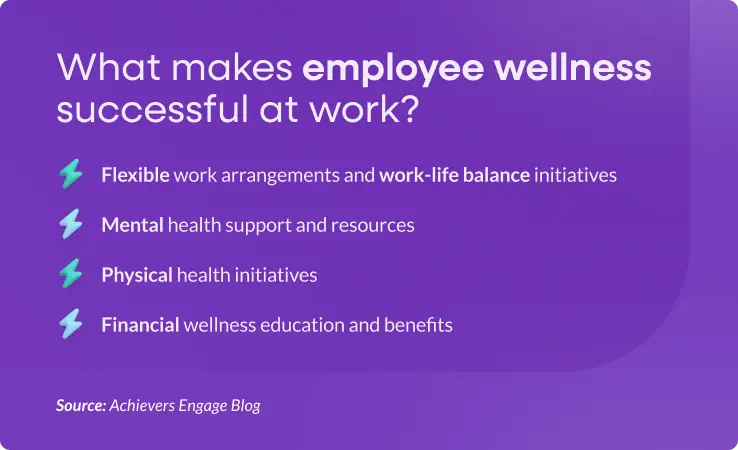Table of contents
Many organizations see wellness programs as optional perks, but they’re actually a smart investment that benefits both the employee experience and the bottom line.
Absenteeism, often driven by disconnection, burnout, and stress, can be costly to businesses — ranging from $2,600 to $3,600 per employee annually. By tackling these underlying issues, wellness initiatives take a preventative approach by nurturing a healthier, more engaged workforce that drives better business outcomes.
When developing employee wellness programs, HR leaders should also factor in the importance of recognition and rewards — as these elements foster a culture of appreciation and support. When employees feel valued, they experience lower stress levels, reduced burnout, higher motivation, and a stronger sense of belonging.
By integrating meaningful recognition with wellness initiatives, companies can create a positive feedback loop — encouraging healthy behaviors, reinforcing company values, and strengthening employee loyalty.
What is employee wellness?
Employee wellness encompasses physical, mental, social, and financial wellbeing, all of which influence workplace performance and satisfaction.
While physical wellness could include healthcare access, fitness programs, and ergonomic workspaces, mental wellness is more focused on delivering psychological safety and work-life balance. Financial wellness can be seen in offering fair compensation or personal finance education, while social wellness cultivates a sense of belonging, connection, and inclusive team dynamics.
When organizations prioritize the holistic wellbeing of their people, employees feel happier and healthier — and have the energy to go the extra mile.
What are examples of employee wellness?
Employee wellness encompasses various aspects of well-being that contribute to a healthier, more engaged workforce. By supporting employees in multiple areas, organizations can foster a positive work environment that enhances productivity and job satisfaction.
Here are some key examples of employee wellness initiatives:
- Physical wellness: Encourages physical health, such as providing healthy snacks, discounts on gym memberships, ergonomic workspaces, and access to preventative healthcare in your benefits package.
- Mental wellness: Supports work-life balance, stress and burnout management, access to mental health resources, and offering free mindfulness app subscriptions.
- Financial wellness: Provides fair compensation, educating employees on financial literacy, support for retirement planning, and student loan assistance.
- Social wellness: Prioritize employee relationship building through shared team experiences, mentorship programs, employee resource groups, and nurturing an inclusive and supportive company culture.
Why companies should prioritize employee wellness
The business case for wellness programs is very compelling. Organizations that invest in holistic employee wellness report a boost in productivity and retention as well as reduced absenteeism. Employees who feel supported in their wellbeing are happier, more motivated and committed, leading to stronger overall organizational health.
In fact, research from the McKinsey Health Institute reveals that investment into holistic employee health could produce an estimated $3.7 trillion to $11.7 trillion of “global economic value.” This translates into an approximate $1,100 to $3,500 per person — accounting for the benefits of lower turnover, absenteeism, presenteeism.
Worth noting is that the greatest possible benefit actually comes from boosting productivity through reducing presenteeism, which is worth approximately $2 trillion to $9 trillion globally. Unfortunately, McKinsey also points out that many companies significantly undervalue the potential of these benefits, because aspects such as attrition and absenteeism are easier to measure and quantify than the cost of presenteeism.
Beyond financial metrics, HR leaders should take into consideration the importance of creating wellness programs that are inclusive to every employee. Inclusive wellness programs go beyond accessibility — they cater to diverse interests and lifestyles, ensuring every employee can engage in ways that feel meaningful to them.
According to SHRM, inclusive wellness programs are linked with a 50% decrease in employee turnover. Whether it’s flexible fitness options, mental health support, or wellness stipends for personal pursuits, these programs recognize that wellbeing looks different for everyone.

What makes employee wellness at work successful?
Successful employee wellness programs take a holistic approach, encompassing work-life balance, mental health, physical wellbeing, and financial education. These can be seen in allowing for remote work, access to mental health resources, or financial literacy education programs that ensure employees feel valued and supported.
Here, we’ll dive into four types of employee wellness including examples and strategies that are inclusive to the needs of your diverse workforce:
1. Flexible work arrangements and work-life balance initiatives
Flexible work arrangements are essential to a positive employee experience, giving individuals the freedom to balance their personal and professional lives. Here are some strategies for integrating work-life balance programs into your organization:
- Remote and hybrid work options: Offering employees the choice to work remotely or in a hybrid setup reduces commuting stress, while allowing them to create a personalized, focused work environment.
- Flexible scheduling: Allowing employees to choose their work hours enables them to manage their personal lives while also aligning their workday with their own peak productivity windows. This ultimately improves job satisfaction and efficiency.
- Encouraging time off: Encouraging employees to take paid time off (PTO) and fostering a culture that respects time away from work helps prevent burnout, reinforcing your company’s commitment to healthy work-life balance.
- Paid parental leave and caregiver support: Offering generous parental leave and caregiving assistance supports employees during important family milestones. It’s an excellent strategy to reduce stress while boosting loyalty.
- No-meeting days or focus hours: Designating specific times for uninterrupted heads down, deep work allows employees to focus on complex tasks without the distraction of meetings. It’s a surefire way to boost focus and output.
2. Mental health support and resources
When it comes to offering mental health support and resources to your employees, companies can leverage some of the strategies below to alleviate stress and prevent burnout before it happens:
- Employee Assistance Programs (EAPs): Offering confidential counseling for personal issues that employees may have in relation to stress and anxiety, helping them navigate their challenges privately.
- Mental health days and stress management: Encouraging employees to take time off for self-care and providing wellness workshops promote stress relief and prevent burnout.
- Manager training on mental health: Taking the time to train your managers on how to recognize and support employees dealing with mental health issues fosters more compassionate and effective leadership.
- Peer support and mindfulness programs: Creating safe spaces for people to share their experiences without judgement, while offering mindfulness training, can boost the mental wellbeing of employees.
- Confidential digital mental health resources: Providing access to mental health apps or online therapy services as a part of a comprehensive benefits package ensures employees can seek help discreetly when they need it.
3. Physical health initiatives
Physical wellbeing programs are key to helping employees stay energized, focused, and productive. Since sitting for extended periods is detrimental to health, these physical wellness strategies are key to keeping your employees happy and healthy:
- Fitness incentives and wellness programs: Offering gym memberships, virtual fitness classes, and on-site wellness activities such as a lunch hour yoga class encourages employees to stay active.
- Ergonomic workplace design: Investing in standing desks, as well as ergonomic chairs and accessories, reduces strain and promotes better posture, contributing to long-term physical health.
- Encouraging movement: Trying out a walking meeting, encouraging stretch breaks, and initiating wellness challenges encourages employees to prioritize movement while combating sedentary behavior.
- Wellness challenges: Motivating employees to engage in physical wellness through friendly competition, such as a step challenge, also has the added benefit of improving connection and work relationships.
- Healthy office environment: Providing nutritious snacks, filling the office with plants, and ensuring clean indoor air quality supports overall physical health while boosting morale and energy levels.
4. Financial wellness education and benefits
Another key component to developing an employee wellness program is offering financial wellness education, as well as other relevant benefits. Here are more strategies that companies can use to boost their employees’ financial wellness:
- Financial advisory services: Offering access to financial planners helps employees to better manage their finances — leading to greater financial literacy and confidence.
- Student loan and tuition assistance: Providing support for student loan repayment and education reimbursement reduces financial stress while encouraging continuous improvement and learning.
- Emergency savings programs: Employer-sponsored savings funds or low-interest loans provide a safety net for employees facing unexpected expenses.
- Fair pay and transparency: Ensuring competitive salaries and clear compensation structures builds trust and promotes financial fairness within the organization.
- Retirement planning support: Educating employees on retirement options, such as 401(k) matching and pensions, helps with securing their long-term financial future.
How Achievers supports employee wellness initiatives
The Achievers Employee Experience Platform takes a holistic approach to helping organizations develop employee wellness programs, by weaving together recognition, rewards, and continuous feedback.
- Recognition as a motivator: By publicly celebrating employees for participating in wellness programs, social recognition creates a positive feedback loop where employees feel empowered to repeat healthy habits and share their success with others.
- Employee rewards that align with wellness: With Achievers, companies can enhance their wellness programs by incorporating employee rewards. Offering incentives for completing a fitness challenge or maintaining a five-day streak in lunchtime yoga sessions encourages movement while reinforcing a culture of recognition and appreciation.
- Listening for continuous improvement: Using Achievers Listen, organizations can gather real-time feedback on wellness programs, getting valuable insights into employee needs and preferences. This allows organizations to continuously refine and improve on their wellness offerings — ensuring that they’re effective and inclusive.
- Building a culture of support: With Achievers, organizations can foster a recognition-rich environment where employees feel seen, valued, and appreciated — reinforcing a sense of connection and belonging.
The power of wellness and recognition
Employee wellness programs are essential to organizational success, as they drive higher engagement, boost retention, reduce burnout and absenteeism. As employees are encouraged to better prioritize their wellbeing at work, companies will also benefit from more employee motivation, productivity, and engagement– directly impacting their bottom line.
An employee recognition program plays a key role in creating wellness initiatives that stick, keeping employees engaged on their wellness journey. That’s because recognition reinforces healthy behaviors that are repeated over time, leading to a compound positive impact.
HR leaders that incorporate Achievers, an all-in-one employee rewards and recognition program, into their wellness strategies have access to a myriad of tools to drive employee engagement and performance. Whether it’s social recognition, wellness rewards, or real-time feedback, organizations can ensure that their wellness programs resonate with their employees while delivering tangible results.
When companies invest in holistic employee wellness, they set the stage for improved organizational health and long-term business success.


